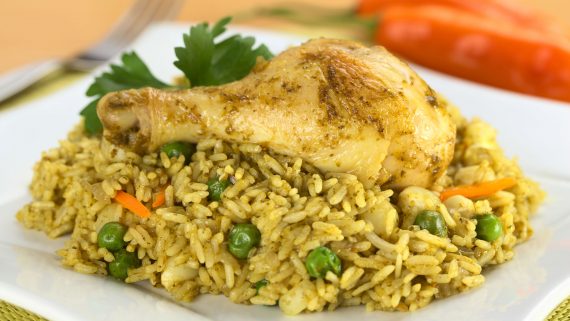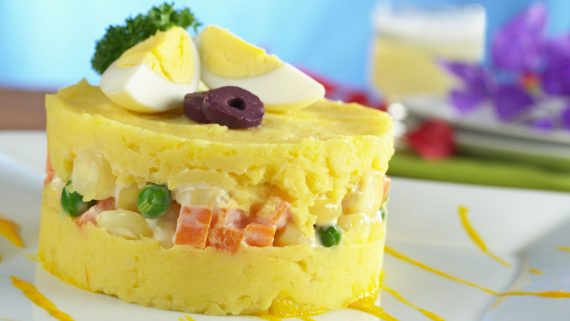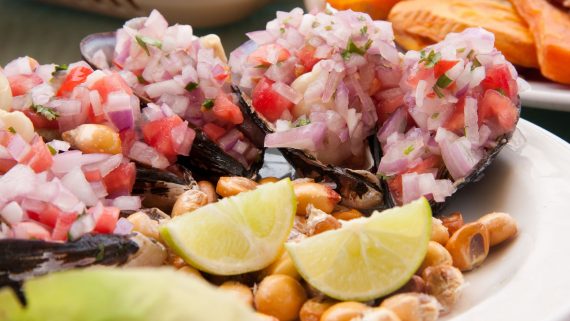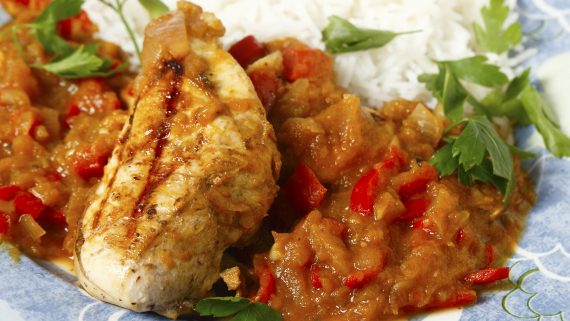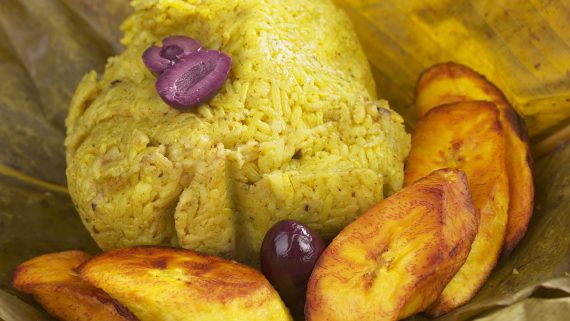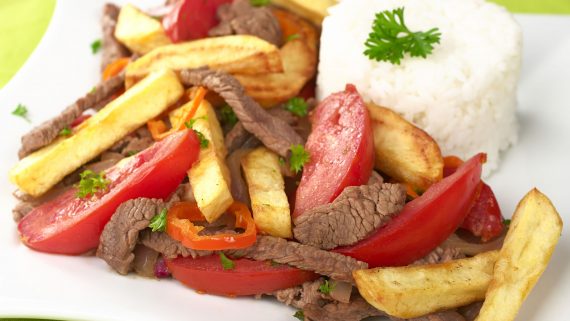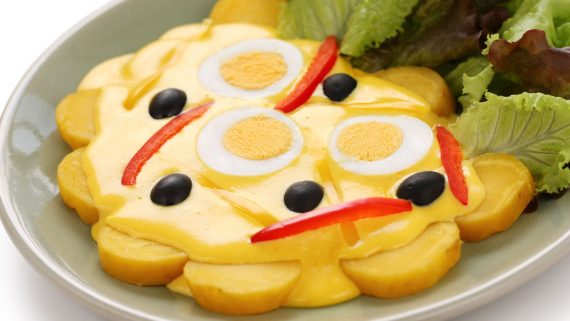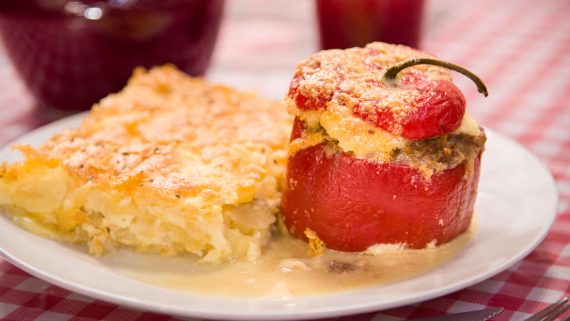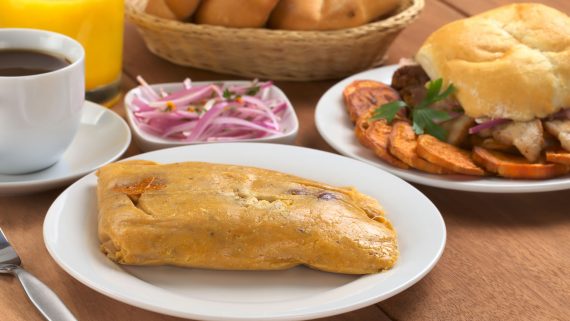Peruvian cuisine has around 500 typical dishes today. The gastronomy of Peru is the result of a fusion with the Spanish cuisine, some customs brought by slaves from sub-Saharan Africa and Chinese, Japanese and Italian immigrants who were arriving during the XNUMXth century.
Below you have an index with all the points that we are going to deal with in this article.
Article Index
- 1.
- 2.
- 3.
- 4.
- 5.
- 6.
- 7.
- 8.
- 9.
- 10.
- 11.
- 12.
- 13.
- 14.
- 15.
- 16.
- 17.
- 18.
- 19.
- 20.
- 21.
- 22.
Chiclayana rice
Name to the chiclayana It comes from the city where this dish was created: Chiclayo, northwest of Peru. Chiclayo is one of the most popular cities in which to enjoy Peruvian cuisine in all its essence.
Specifically, the recipe for arroz a la chiclayana can be made with chicken, duck or any other type of meat. Among the essential ingredients is the pumpkin loche grated, green peas, chicha de jora or black beer and a tie of coriander.
Loche squash is a pre-Columbian product native to the area and is usually used in a large number of dishes. It is grown in the valleys of Túcume, Íllimo, Mórrope, Ferreñafe, Pítipo, Monsefú and Pimentel. It is estimated that its use in the diet dates back to the first civilizations that inhabited this area.
Peruvian chaufa rice
The chaufa rice recipe is among the essentials of Peruvian cuisine. It consists of fried rice mixed with various types of meat and soy sauce. Actually, the dish is based on the Chinese gastronomy, since it was brought to the country by the chinese chefs that were settling in the country from the XIX century.
Peruvians began to refer to Cantonese food that was being introduced into the country under the term of Who does, origin of the name bye which gives this rice dish its name. In short, arroz chaufa is the result of the fusion between the Chinese Food and the Peruvian that took place at that time.
Legend has it that this delicious dish began to gain fame from the moment a high-ranking Chinese official visited Peru and was honored by the authorities with a plate of chaufa rice. The official liked this dish, pointing out that it was an exquisite Peruvian dish, when in fact it had been the work of Chinese cooks who had migrated to Peru.
Peruvian rice with chicken
As simple as the name may seem, arroz con pollo is a traditional Peruvian recipe. Green in appearance, it is a plate very tasty due to the variety of ingredients it includes. Thus, it is dressed with a bramble of onions, which greatly enhances the flavor.
The rice with chicken that is cooked in Peru has many similarities with the famous Valencian paella, one of the symbols par excellence of Spanish cuisine. In Ecuador, there is the so-called yellow rice, a very original dish in which the yellow color of the rice is achieved through the use of achiote. In Colombia, it is known as shredded chicken rice.
In Peru, this international dish is added cilantro, one of the most used ingredients in Peruvian cuisine. In addition, coriander stains the dish a slightly greenish color, which makes a difference compared to rice with chicken consumed in other countries.
Cau Cau
This original denomination dish is another of the main Peruvian gastronomy and consists of a mixture of chicken tripe with yellow potatoes. Potatoes are striking because of the way they are cut, that is, into small squares. They are cooked with ají amarillo, parsley, onion and garlic.
Chicken tripe It is the name that is used in many Latin American countries to refer to cow guts. In Spain, they are known as "callos", while in other Latin American countries names such as guatita, pancita, menudo or tripa mishque are used.
There are several theories to explain the name of the dish. One is the one that says it comes from the Quechua words can (trifle) or acacau (hot).
For others, it is due to the Chinese immigrants of the XNUMXth century, who said caucau to indicate that the ingredients should be cut into very small portions. Others simply consider that cause is an adaptation of the English word cow, in other words, cow.
Cause a la Lima
The Peruvian dish known as cause the limeña Or simply, cause It is another of the most representative of Peruvian gastronomy. Its origin dates from before the Columbian era, since it was previously prepared in Peru from yellow potatoes, kneading it and mixing it with crushed chili.
At present, to prepare Lima cause the following ingredients are needed: Peruvian yellow potato, chili, lettuce, lemon, boiled egg, avocado and black olives. However, there are those who add other ingredients (eg mayonnaise or tuna) or ignore some of those mentioned above, since it is a dish that admits several variations.
The name of cause comes from the Quechua language, specifically from the term kausay, whose literal meaning is food o necessary sustenance. This name was also given to the yellow potato.
According to another theory, the name is due to the time of the viceroyalty (XNUMXth-XNUMXth centuries), when the liberator José de San Martín asked to support "the cause" by purchasing this plate in order to pay for the expenses of the military campaign. It is estimated that it was at this time that the set was left with the name of cause.
Peruvian Ceviche
The ceviche, also written cebiche, seviche o sebiche (all forms accepted by the RAE), is a dish originally from Peru, but whose great success has crossed borders and is currently typical in almost all Latin American countries along the Pacific coast, such as Colombia, Chile, Ecuador, Costa Rica, Guatemala, The Savior, Honduras, Mexico, Nicaragua ...
In Peru, ceviche is not merely a typical dish, but a sign of national identity that, in fact, has been declared Cultural Patrimony of the Nation. Although it is consumed throughout the country, it is especially popular in the north. It is traditionally served in a restaurant known as cevicheria.
The basic ingredients of any Peruvian ceviche dish are chopped fish, onion and juice. Piuran lemon from the Tamborgrande Valley. In relation to this last ingredient, it is said that the ceviche is original from the city of Piura.
Various citrus fruits to taste are used for the dressing, although the most common are Piuran lemon and acid lime. However, in Ancient Peru, specifically after the arrival of the first Spaniards, sour orange and onion were added, two typical ingredients of Mediterranean cuisine. Chopped cilantro and a sweet potato or yuca garnish are also added.
Mussels to the chalaca
Cry It is the common name given to an edible mollusk of the mussel family native to South America, where it can be found especially on the coasts of Peru and Chile. In the latter country, it is known by the name of cholga o cholgua.
The choritos a la chalaca are prepared with raw mussels, chopped tomato and onion, lemon juice and boiled corn kernels. This is the traditional recipe of Callao, a coastal city located on the west-central coast of Peru, where fish and shellfish are essential food for its inhabitants.
As you can see in the photo, they are prepared in the shell of the mussels, which are previously macerated with lemon juice. It is also used, as in many other Peruvian dishes, diced chili pepper or rocoto. Some recipes also include the use of choclo (young corn).
Shrimp soup
Shrimp chupe is one of the most emblematic dishes of Peruvian cuisine. One of the advantages of this delicious dish is that it can be served both as a first or second course, since it is a abundant food which can accommodate many diners.
Broadly speaking, shrimp chupe is a fish soup, but the necessary ingredients must be used in the right amount as dictated by the original recipe to make it a true Peruvian shrimp chupe.
Ingredients include fresh shrimp (including the shells, since the broth is made with them), Andean potatoes, a little white cheese, corn, garlic, tomato, onion, rice, eggs, coriander, a pinch of oregano and a little Peruvian yellow pepper.
Stuffed empanadas
The Peruvian baked empanadas are prepared with an easily crumbly dough, which is filled with a stew made of meat, vegetables and various spices, such as p, cumin, yellow pepper, etc. The most commonly used meats are beef and chicken.
When it comes to vegetables, the most common are potatoes, coriander, onion and corn kernels. Depending on who makes it, these vegetables can vary, since the stuffed empanadas recipe is very open to the imagination.
The cooking method is baked and the shape that is usually given to the empanadas is also very varied. They can be found square, rectangular, triangular, rounded, in the shape of a half moon ... However, the most seen are these last two.
There are some variants which include fillings such as ají de gallina, lomo saltado or pork rinds, although these ingredients are not part of the original recipe for Peruvian stuffed empanada, but are the result of the arrival of immigrants from various parts of the world to Peru.
Marinade
The Peruvian pickle is a dish that can be consumed both at family gatherings and during the week, mainly because it can be consumed cold or hot and be just as delicious. Its basic ingredients are pickled or yellow chili, lots of vinegar and onion.
The marinade is usually made with chicken. In addition, other ingredients are added such as garlic, ground panca pepper, yellow pepper in strips, cumin, olive oil, hard-boiled eggs, botija olives, oregano, red vinegar, sweet potatoes and lettuce.
For the result to be optimal and according to the traditional Peruvian recipe, the first thing to do is season the chicken with salt and pepper, then boil it in water with vinegar and salt, drain the chicken and, finally, fry it in oil.
Peruvian Juane
The juane or juan is one of the most representative dishes of the gastronomy of the Peruvian jungle, specifically from the city of Santiago and Moyobamba. It is especially typical during the festival of San Juan, which is celebrated every June 24.
There are several versions of the juane, although the original is made from yucca, rice and chicken. However, other versions are the traditional juan, the special one, that of chonta, wasp juane, nina juane or sara juane, among others.
It is called Juane o Juan in honor of San Juan Bautista and is estimated to be a plate of pre-Columbian origin, although this name was assigned to it from the arrival of the Spanish to Inca lands, when the Christian religion began to spread among the natives.
The history of juane is not clear, but it is estimated that it was a food usually prepared for travelers, since it has the advantage of being able to be stored for long periods of time without decomposing or altering the quality of the food.
Salted loin
The lomo saltado is a dish that dates back to the XNUMXth century, when it was known by various names (eg. beef tenderloin, salted tenderloin o chorrillana tenderloin). This dish, like arroz chaufa, is highly influenced by Chinese-Cantonese cuisine.
This influence of oriental cuisine It is demonstrated above all because it is cooked in a pan, which is why it is called lomo saltado. However, there are variants that have emerged over the years, especially in the use of ingredients.
Thus, the traditional recipe incorporates ingredients such as beef, salt, cumin, pepper, green chili, garlic, red or white vinegar, potatoes, oil, tomato and parsley. On occasions, soy sauce and pisco are added, the latter recognized as one of the most emblematic drinks in Peru.
Toasted court
The toasted court, also known as Court Serrana o court, it is nothing but roasted corn. It is a dish that is usually included in any Peruvian garnish, especially in the Peruvian Andes.
Its preparation is very simple: just heat a clay pot or a frying pan, add a little butter or oil and fry them with a little salt. The grains, which must be yellow cornThey should be stirred without dinner until they acquire a golden appearance.
The court is especially used to accompany dishes such as ceviche or chicharrones. Its consumption in Peruvian Andes It dates from the 1608th century, since they are already mentioned in González Holguín's Quechua-Spanish Dictionary, published in XNUMX.
Pachamanca
Pachamanca is another of the most traditional dishes in Peru. The ancestral custom dictates that it must be made by cooking beef, pork, chicken and guinea pig meat in the heat of the preheated stones. The meats are pre-seasoned with ingredients such as chincho, cumin, chili, huacatay, pepper and various spices.
Name Pachamanca comes from the Quechua language, where pacha means land y manka equivalent to olla, so it literally means pot of earth and this is the reason why it should be cooked as explained above.
Currently, pachamanca is also prepared in a pot, so it is common to call it pachamanca to the pot. To the various meats used are added various vegetables, such as potatoes, sweet potatoes, broad beans, yuccas, corn and plantain, among others. Cheese and humitas are also usually added.
Huancaina's style potato
The huancaína potato is one of the most popular dishes on the Peruvian coast and mountains, and in general throughout Peru. However, it is important to be clear that the dish is not originally from Huancayo, as it might seem from its name, but from Lima, the capital of Peru.
It is a very simple dish to prepare, although the only part that could present a greater degree of difficulty is the preparation of the sauce, which is the distinctive element of this dish. Thus, for its preparation, fresh cheese is used, which is mixed with oil, salt, yellow pepper and milk. It is important that all these ingredients are well blended so that they do not present lumps.
It is also important to remove the skin of the chili pepper, since in this way we avoid the appearance of remains of the yellow pepper peel. The best way to avoid this is by previously boiling the chili in water for a few seconds.
As for the presentation, as can be seen in the photo, a lettuce leaf is usually placed at the base of the plate, on top of which are added some slices of boiled potato. Finally, it is added sliced hard-boiled egg and olives. It can be taken as a main or second dish.
Parihuela
As in the case of chupe, the stretcher is a soup widely consumed on the coast of Peru. Its ingredients are seafood and various fish, which is why it is popularly known as "stretcher lifts dead", since it is considered to be a great source of nutrients.
The most common types of fish in this dish are those mentioned below: cabrilla, corvina or cojinova and machete. These fish are used in particular because their mixture with different seafood produces this tasty soup so popular in Peruvian cuisine.
In fact, the stretcher and its resulting effect on the user is seen as a aphrodisiac, mainly due to its high phosphorous content. In fact, there are those who consider that it is very similar to the bouillabaisse or bouillabaisse, one of the typical dishes of France, specifically from the Provence region.
Hot bite
The hot snack is actually a very popular snack in Peru, where the best can be eaten in Lima, its capital. It is tradition to serve it in a oval font and normally the same dish is designed for two people.
It is a tradition to add two small shells with salt and burning alcohol, which is lit when the snack is served. Almost all the ingredients that include the nibble are battered and usually consist of fish such as squid, octopus and sea bass.
It is also common to add stuffed mushrooms medium-sized shrimp, to which is added a touch of grated Parmesan cheese and white wine. Finally, they are gratinated in the oven and placed randomly in various parts of the snack plate.
Stuffed hot pepper
The stuffed rocoto is a dish of Arequipa origin for which it is used, as its name suggests, rocoto. It is a fruit similar to chili pepper and the size of an apple whose flavor is very spicy, although it is somewhat sweeter than chili.
Due to the use of hot peppers, this is a dish considered spicy. The rocotos are filled with Ground beef, peas, olives and fresh cheese. All of this is garnished with cumin and chopped parsley. Once this step is taken, everything is put into the oven and eaten hot.
In Arequipa, Lima and most Peruvian restaurants, the stuffed rocoto is served with roasted potatoes, which have been baked along with the rocoto. In some versions, the traditional potato cake is added, for which white potato, tumbay or cottage cheese is used.
Carapulcra and chinchana dry soup
The name of chinchana It is because the origin of this dish is the province of Chincha, in the Department of Ica. It is not surprising that this varied dish comes from this area of Peru, since it is one of the most mixed-race places in the country.
This dish is the result of a mixture of ingredients typical of the Chinese, Italian and Spanish gastronomy, among others. It is a kind of stew whose origin dates back to wedding banquets, where the parents of the groom and the bride competed to be the ones who best entertained the bride and groom. Finally, it was decided to mix everything in one dish.
Thus, this dish is a symbol of celebration and celebration for which it is used chicken, noodles, chopped onion, cumin, ground achiote, chopped tomato without skin, basil, parsley and olive oil. To make the chinchana carapulcra, you need pork, potato tomasa, ground panca pepper, freshly roasted peanuts and boiled yucca.
Fish tiradito
Tiradito is made with fresh raw fish cooked with lemon juice. In many areas of Peru it is considered a cousin of ceviche because of the variety of similarities that exist between them. The most common fish for the tiradito are: pejerrey, cojinova, palmerita or parakeet.
However, the main difference with ceviche is that the tiradito does not have onion and the fish is cut into thin slices. In fact, the way to cut them is very similar to sashimi of typical Japanese food or the carpaccio of the Italian gastronomy. In addition, the tiradito is also eaten cold.
Before starting to fillet the fish, the first thing to do is marinate the lemon juice with coriander, salt, pepper, garlic and parsley. It is also important to prepare a chili cream, which will give the dish a Peruvian touch. The chili mixture must be mixed with the lemon juice to finally pour the resulting mixture over the raw fish fillets.
Peruvian tamale
The tamale is a dish of Amerindian origin that is prepared in practically all the countries of Latin America. In general, it consists of a corn dough filled with meat, vegetables, chili peppers, sauces, fruits ... All of this is wrapped in corncob leaves, bijao, avocado, maguey or even aluminum foil and is cooked in water or al steam.
Specifically, the Peruvian tamale is prepared corn-based, although the recipe may vary depending on the area of Peru where it is prepared. Thus, on the Peruvian coast it is stuffed with beef, chicken or pork and egg, olives or peanuts are added. Northerners add coriander, which gives it a very characteristic green color. In the Sierra, the recipe is similar to that of the pachamanca.
The result of these variations by region is the existence of several types of tamales: yellow corn wrapped in banana leaves, with white or mote corn, Piuran green tamales, dry corn flour or even sweet (known as humitas). The size can also vary by area. Thus, in the southern zone they tend to be quite large sizes, weighing up to 2 kg.
Tacu tacu
The tacu-tacu is one of the typical dishes of Peru whose origin is due to the Creole food. According to several historians, black slave women used all the food left over from other dishes to make the tacu-tacu (hence its name, which comes from the Quechua term takuy, Meaning mix one thing with the other).
The traditional recipe indicates that it should be prepared with cooked rice and beans from the day before. All this must be mixed to form a homogeneous mass, which will be heated in a pan. The most common is that the stew includes beans, lentils and lima beans. Finally, the dough is fried to make it crisp.
There are several specialties, such as: bean tacu-tacu, pallares tacu-tacu, blanket tacu-tacu (accompanied by breaded steak or a milanesa), tacu-tacu stuffed with seafood, tacu-tacu bathed in seafood sauce, etc.
The preparation of this dish is a common practice among Afro-descendants of various regions of America. Thus, there are very similar dishes in different Latin American countries such as the famous gallo pinto in Nicaragua, the congri in Cuba, the feijoada in the brazilian gastronomy or the Moorish rice among the typical dishes of the Dominican Republic.
This article has been shared 829 times. We have spent many hours collecting this information. If you liked it, share it, please:



